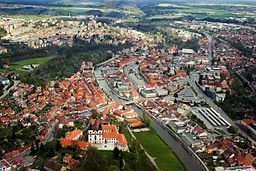Třebíč
| Třebíč | |||
| Town | |||
|
Aerial view of center of Třebíč
|
|||
|
|||
| Name origin: from name Třebek | |||
| Nickname: Třeb | |||
| Country | Czech Republic | ||
|---|---|---|---|
| Region | Vysočina | ||
| District | Třebíč | ||
| Commune | Třebíč | ||
| River | Jihlava | ||
| Elevation | 405 m (1,329 ft) | ||
| Coordinates | 49°13′N 15°52′E / 49.217°N 15.867°ECoordinates: 49°13′N 15°52′E / 49.217°N 15.867°E | ||
| Area | 57.6 km2 (22.2 sq mi) | ||
| Population | 36,641 (2016) | ||
| Density | 636/km2 (1,647/sq mi) | ||
| First mentioned | 1277 | ||
| Mayor | Pavel Janata | ||
| Timezone | CET (UTC+1) | ||
| - summer (DST) | CEST (UTC+2) | ||
| Postal code | 674 01 | ||
| UNESCO World Heritage Site | |||
| Name | Jewish Quarter and St. Procopius' Basilica in Trebíc | ||
| Year | 2003 (#27) | ||
| Number | 1078 | ||
| Region | Europe and North America | ||
| Criteria | ii, iii | ||
| Statistics: statnisprava.cz | |||
| Website: www.trebic.cz | |||
Třebíč (Czech pronunciation: [ˈtr̝̊ɛbiːtʃ]; German: Trebitz) is a town in the Moravian part of the Vysočina Region of the Czech Republic.
Třebíč is situated 35 km southeast of Jihlava and 65 km west of Brno on the Jihlava River. Třebíč's elevation is from 392 to 503 metres above sea-level.
Třebíč has a temperate climate with occasional rains. Average annual temperature is 7.5 °C, average temperature in July is 18.5 °C and −3.4 °C in January.
Třebíč is a regional centre with a population of approximately 40,000. In the age of expansion, Třebíč was the third most important town in Moravia. The population growth started after World War II. Třebíč is the administrative capital of the Třebíč District.
There are many well-known tourist sights. The Jewish Quarter and St. Procopius Basilica are listed as a UNESCO World Heritage Site.
Nearly 37 thousand people lived in Třebíč in 2016. Beginning of the town's history is connected with an establishment of Benedictine monastery, where the castle is located today.
The historical treasury of Třebíč includes the old Jewish Quarter and the large Romanesque St Procopius' Basilica, which incorporates some later Gothic features, including a rare example of a ten-part (also known as 'botanical') rose window. Such designs reflect the five or ten parts of the roseaceae family flowers and fruit, based on their five sepals and petals or the usual ten segments of their fruit. Botanical rose windows contrast with more complex Gothic windows that contain more segments (usually multiples of traditional gothic units of design – three trefoil, or four quatrefoil). Another thesis says that these decorations are based on an ancient design, inspired by forerunners in the wheel of life, associated with eastern religions nowadays, or may allude to the Virgin Mary.
...
Wikipedia





